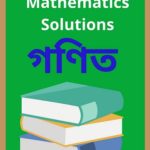SEBA Class 10 Mathematics Chapter 7 Coordinate Geometry Solutions, SEBA Class 10 Maths Textbook Notes in English Medium, SEBA Class 10 Mathematics Chapter 7 Coordinate Geometry Notes in English to each chapter is provided in the list so that you can easily browse throughout different chapter Assam Board SEBA Class 10 Mathematics Chapter 7 Coordinate Geometry Notes and select needs one.
SEBA Class 10 Mathematics Chapter 7 Coordinate Geometry
Also, you can read the SCERT book online in these sections Solutions by Expert Teachers as per SCERT (CBSE) Book guidelines. SEBA Class 10 Mathematics Chapter 7 Coordinate Geometry Question Answer. These solutions are part of SCERT All Subject Solutions. Here we have given SEBA Class 10 Mathematics Chapter 7 Coordinate Geometry Solutions for All Subject, You can practice these here.
Coordinate Geometry
Chapter – 7
| Exercise 7.1 |
1. Find the distance between the following pairs of points:
(i) (2, 3), (4, 1)
Ans:
(ii) (−5, 7), (−1, 3)
Ans:
(iii) (a, b), (− a, − b)
Ans:
2. Find the distance between the points (0, 0) and (36, 15). Can you now find the distance between the two points A and B discussed in Section 7.2.
Yes, we can find the distance between the given towns A and B. Assume town A at origin point (0, 0). Therefore, town B will be at point (36, 15) with respect to town A. And hence, as calculated above, the distance between town A and B will be 39 km.
3. Determine if the points (1, 5), (2, 3) and (-2, -11) are collinear.
Ans: Let the points (1, 5), (2, 3), and (-2, -11) be representing the vertices A, B, and C of the given triangle respectively.
Therefore, the points (1, 5), (2, 3), and (−2, −11) are not collinear.
4. Check whether (5, -2), (6, 4) and (7, -2) are the vertices of an isosceles triangle.
Ans: Let the points (5, -2), (6, 4), and (7, -2) are representing the vertices A, B, and C of the given triangle respectively.
As two sides are equal in length, therefore ABC is an isosceles triangle.
5. In a classroom, 4 friends are seated at the points A, B, C and D as shown in the following figure. Champa and Chameli walk into the class and after observing for a few minutes Champa asks Chameli, “Don’t you think ABCD is a square?” Chameli disagrees. Using the distance formula, find which of them is correct.
Ans: It can be observed that A (3, 4), B (6, 7), C (9, 4), and D (6, 1) are the positions of these 4 friends.
It can be observed that all sides of this quadrilateral ABCD are of the same length and also the diagonals are of the same length. Therefore, ABCD is a square and hence, Champa was correct.
6. Name the type of quadrilateral formed, if any, by the following points, and give reasons for your answer:
(i) (-1, -2), (1, 0), (-1, 2), (-3, 0)
Ans:
(ii) (− 3, 5), (3, 1), (0, 3), (-1, -4)
Ans: A(-3, 5), B(3, 1), C(0, 3),D(-1, -4) are the given points.
(iii) (4, 5), (7, 6), (4, 3), (1, 2)
Ans: Let the points (4, 5), (7, 6), (4, 3), and (1, 2) be representing the vertices A, B, C, and D of the given quadrilateral respectively.
It can be observed that opposite sides of this quadrilateral are of the same length.
However, the diagonals are of different lengths.
Therefore, the given points are the vertices of a parallelogram.
7. Find the point on the x-axis which is equidistant from (2, -5) and (-2, 9).
Ans: We have to find a point on x-axis.
Therefore, its y-coordinate will be 0.
By the given condition, these distances are equal in measure
8. Find the area of the triangle formed by the points A (5, 2), B (4, 7) and C (7, -4).
Ans: The area of the triangle formed by the points A (5, 2), B (4, 7) and C (7, -4) is given by
Since area is a measure, which cannot be negative, we will take the numerical value of -2, i.e., 2.
Therefore, the area of the triangle = 2 square units.
9. If Q(0, 1) is equidistant from P(5, -3) and R(x, 6). Find the values of x. Also find the distances QR and PR.
Ans:
10. Find a relation between x and y such that the point (x, y) is equidistant from the point (3, 6) and (-3, 4).
Ans: Point (x, y) is equidistant from (3, 6) and (−3, 4).
| Exercise 7.2 |
1. Find the coordinates of the point which divides the join of (-1, 7) and (4, -3) in the ratio 2:3.
2. Find the coordinates of the points of trisection of the segment joining the points (4, -1) and (-2, -3)
Ans:
Points P and Q trisect the line segment joining the point A(4, -1) and B(-2, -3)
i.e., AP = PQ = QB
Here, P divides AB in the ratio 1:2 and Q divides AB in the ratio 2:1
3. To conduct Sports Day activities, in your rectangular shaped school ground ABCD, lines have been drawn with chalk powder at a distance of 1m each. 100 flower pots have been placed at a distance of 1 m from each other along AD, as shown in the following figure. Niharika runs 1/4th the distance AD on the 2nd line and posts a green flag. Preet runs 1/5th the distance AD on the eighth line and posts a red flag. What is the distance between both the flags? If Rashmi has to post a blue flag exactly halfway between the line segment joining the two flags, where should she post her flag?
Ans: It can be observed that Niharika posted the green flag at 1/4 of the distance AD i.e.,
4. Find the ratio in which the line segment joining the points (-3, 10) and (6, -8) is divided by (-1, 6).
Ans: Let the ratio in which the line segment joining (−3, 10) and (6, −8) is divided by point (−1, 6) be k:1.
5. Find the ratio in which the line segment joining A (1, -5) and B (-4, 5) is divided by the x-axis. Also find the coordinates of the point of division.
Ans: Let the ratio in which the line segment joining A (1, −5) and B (−4, 5) is divided by x – axis be k:1
x – axis be k:1
6. If (1, 2), (4, y), (x, 6) and (3, 5) are the vertices of a parallelogram taken in order, find x and y.
Ans:
Let (1, 2), (4, y), (x, 6), and (3, 5) are the coordinates of A, B, C, D vertices of a parallelogram ABCD. Intersection point O of diagonal AC and BD also divides these diagonals.
Therefore, O is the midpoint of AC and BD. If O is the midpoint of AC, then the coordinates of O are
7. Find the coordinates of a point A, where AB is the diameter of a circle whose centre is (2, −3) and B is (1, 4).
Ans: Let the coordinates of point A be (x, y).
Midpoint of AB is (2, −3), which is the centre of the circle.
8. If A and B are (-2, -2) and (2, −4), respectively. Find the coordinates of P such that AP = 3/4 AB and P lies on the line segment AB.
Ans:
9. Find the coordinates of the points which divide the line segment joining
A (-2, 2) and B (2, 8) into four equal parts.
Ans: Points P, Q, R, divides AB into four equal parts.
AB = PQ = QR = RB
10. Find the area of a rhombus if its vertices are (3, 0), (4, 5), (-1, 4) and
(-2, -1) taken in order. ( Hints: Area of a rhombus = ½ (product of its diagonals)
Ans:
| Exercise 7.3 |
1. Find the area of the triangle whose vertices are:
(i) (2, 3), (-1, 0), (2, -4)
Ans: Let A (2, 3), B (-1, 0), C (2, -4) are the vertices of the given triangle.
x1 = 2, x2 = -1, x3 = 2
y1 = 3, y2 = 0, y3 = -4
(ii) (-5, -1), B(3, -5), (5, 2)
Ans: Let A(-5, -1), B(3, -5), C(5, 2) are the vertices of the given triangle.
x1 = -5, x2 = 3, x3 = 5
y1 = 1, y2 = -5, y3 = 2
2. In each of the following find the value of k, for which the points are collinear.
(i) (7, -2), (5, 1), (3, k)
Ans: A(7, -2), B(5, 1), C(3, k) are the given points.
x1 = 7, x2 = 5, x3 = 3
y1 = -2, y2 = 1, y3 = k
The condition for three points to be collinear is
x1 (y2 – y3) + x2 (y3 – y1) + x3 (y1 – y2) = 0
i.e. 7 × (1 – k) + 5 × (k + 2) + 3 × (-2 – 1) = 0
i.e. 7 – 7k + 5k + 10 – 9 = 0
i.e., -2k + 8 = 0, i.e, k = 4
(ii) (8, 1), (k, -4), (2, -5)
Ans: As in part (i) the condition for the three points to be collinear is
8 × (-4 + 5) + k × (-5 – 1) + 2 × (1 + 4) = 0
i.e. 8 – 6k + 10 = 0 i.e., 6k = 18 i.e. k = 3
3. Find the area of the triangle formed joining the midpoints of the sides of the triangle whose vertices are (0, -1), (2, 1) and (0, 3). Find the ratio of this area to the area of the given triangle.
Ans: D, E, F are the mid-points of the sides AB, BC, CA respectively of the ∆ABC.
4. Find the area of the quadrilateral whose vertices, taken in order, are (-4, -2), (-3, -5), (3, -3) and (2, 3).
Ans: We have made the rough sketch of the given quadrilateral ABCD, Join the diagonal AC.
5. You have studied in Class IX, (chapter 9, example 3), that a median of a triangle divides it into two triangles of equal areas. Verify this results of ∆ABC whose vertics are A(4, -6), B(3, -2) and C(5, 2).
Ans: A median of triangle divides the triangle into two triangles of equal areas. Verify this result for ∆ABC whose vertics are A(4, -6), B(3, -2) and C(5, 2).
Let A(4, -6), B(3, -2) and C(5, 2) be the vertics of ∆ABC. AD is median.
∴ ar(∆ADC) = 3 sq. units
∴ AD divides the ∆ABC into two equals areas.
| Exercise 7.4 |
1. Determine the ratio in which the line 2x + y – 4 = 0 divides the line segment joining the points A(2, -2) and B(3, 7).
Ans: Let the line 2x + y – 4 = 0 divides the line segment joining the point A(2, -2) and B(3, 7) at C. Again let AC : CB = k : 1
∴ Required ratio = k : 1 = 2/9 : 1 = 2 : 9
2. Find a relation between x and y if the points (x, y), (1, 2) and (7, 0) are collinear.
Ans: Given pts are collinear if
x1 (y2 – y3) + x2 (y3 – y1) + x3 (y1 – y2) = 0
⇒ x(2 – 0) + 1(0 – y) + 7(y – 2) = 0
⇒ 2x – y + 7y – 14 = 0
⇒ 2x + 6y – 14 = 0
⇒ x + 3y – 7 = 0 [Dividing both sides by 2]
3. Find the centre of a circle passing through the points (6, -6), (3, -7) and (3, 3).
Ans: Let P(x, y) be the centre of the circle
Let A(6, -6), B(3, -7) and C(3, 3)
PA = PB = PC = radius
PA2 = PB2 = PC2
Now, PA2 = (x – 6)2 + (y + 6)2
= x2 – 12x + 36 + y2 + 12y + 36 …(1)
PB2 = (x – 3)2 + (y + 7)2
= x2 – 6x + 9 + y2 + 14y + 49 …(2)
PC2 = (x – 3)2 + (y – 3)2
= x2 – 6x + 9 + y2 – 6y + 9 …(3)
From (2) and (3)
x2 – 6x + 9 + y2 + 14y + 49 = x2 – 6x + 9 + y2 – 6y + 9
⇒ 14y + 6y = 18 – 58 ⇒ 20y = -40 ⇒ y = -2 …(4)
From (1) and (2)
x2 – 12x + 36 + y2 + 12y + 36 = x2 – 6x + 9 + y2 + 14y + 49
⇒ -12x + 6x + 12y – 14y = 58 – 72
⇒ -6x – 2y = -14
⇒ -6x – 2(-2) = -14 [From (4)]
⇒ -6x = -14 – 4 ⇒ x = 18/6 = 3
∴ Centre O(3, – 2)
4. The two opposite vertices of a square are (-1, 2) and (3, 2). Find the coordinates of the other two vertics.
Ans: Let A (-1, 2), B (x, y), C (3, 2) and AB = BC [All sides are equal]
⇒ AB2 = BC2
⇒ (x + 1)2 = BC2
⇒ (x + 1)2 + (y – 2)2 = (x – 3)2 + (y + 2)2
⇒ x2 + 2x + 1 + y2 – 4y + 4 = x2 – 6x + 9 + y2 + 4y + 4
⇒ 8x = 8 ⇒ x = 1
In right, ∆ABC, AB2 + BC2 = AC2
⇒ (1 + 1)2 + (y – 2)2 + (1 – 3)2 + (y – 2)2 = (3 + 1)2 + (2 – 2)2
⇒ 4 + (y – 2)2 + 4 + (y – 2)2 = 16
⇒ 2(y – 2)2 = 8
⇒ (y – 2)2 = 4
⇒ y – 2 = + 2 ⇒ y = + 2 + 2
⇒ y = 4 or y = 0
∴ Pt. D (1, 4), Pt. B (1, 0)
5. The class X students of a secondary school in Krishinagar have been allotted a rectangular plot of land for their gardening activity. Sapling of Gulmohar are planted on the boundary at a distance of 1m from each other. There is a triangular grassy lawn in the plot as shown in the fig. The students are to sow seeds of flowering plants on the remaining area of the plot.
(i) Taking A as origin, find the coordinates of the vertices of the triangle.
(ii) What will be the coordinates of the vertices of ∆PQR if C is the origin?
Ans: (i) Taking A as origin, we get P(4, 6), Q(3, 2), R(6, 5)
(ii) Taking C as origin P(12, 2), Q(13, 6), R(10, 3)
Case I. When P(4, 6), Q(3, 2) and R(6, 5)
or (∆PQR) = 1/2 [4(2 – 5) + (5 – 6) + 6(6 – 2)]
= 1/2 [-12 – 3 + 24] = 9/2 sq. units …(i)
Case II. When P(12, 2), Q(13, 6), R(10, 3)
ar (∆PQR) = 1/2 [12(6 – 3) + 13(3 – 2) + 10(2 – 6)]
= 1/2 [36 + 13 – 40] = 9/2 sq. units …(ii)
From (i) and (ii), Areas are the same in both the cases.
6. The vertix of ∆ABC are A(4, 6), B(1, 5) and C(7, 2). A line is drawn to intersect sides AB and AC at D and E respectively, such that AD/AB = AE/AC = 1/4. Calculate the area of the ∆ADE and compare it with the area of ∆ABC. (Recall Theorem 6.2 and Theorem 6.6)
Ans: (i) AD/AB = 1/4, AE/AC = 1/4
Let AD = 1k, AB = 4k
BD = AB – AD = 4k – 1k = 3k
AD/BD = 1k/3k = 1/3
Similarly, AE : EC = 1 : 3
Using section formula, the coordinates of D and E.
∴ Required ratio = 1 : 16
7. Let A(4, 2), B(6, 5) and C(1, 4) be the vertices of ∆ABC.
(i) The median from A meets BC at D. Find the coordinates of the point D.
Ans: Mid point of BC
(ii) Find the coordinates of the point P on AD such that AP : PD = 2 : 1.
Ans: AP : PD = 2 : 1
Coordinates of
(iii) Find the coordinates of Q and R on medians BE and CF respectively such that BQ : QE = 2 : 1 and CR : RF = 2 : 1.
Ans:
(iv) What do you observe?
Ans: P = Q = R = G = centroid of ∆ABC
The point which is common to all the three medians is called the centroid and this point divides each median in the ratio 2 : 1
∴ P, Q, R are the same points.
(v) If A x1, y), B(x2, y2) and C(x3, y3) are the vertices of ∆ABC, find the coordinates of the centroid of the triangle.
Ans: Mid point of BC,
8. ABCD is a rectangle formed by the points A(-1, -1), B(-1, 4), C(5, 4) and D(5, -1). P, Q, R and S are the mid-points of AB, BC, CD and DA respectively. Is the quadrilateral PQRS a square? A rectangle or a rhombus? Justify your answer.
Ans:

Hi, I’m Dev Kirtonia, Founder & CEO of Dev Library. A website that provides all SCERT, NCERT 3 to 12, and BA, B.com, B.Sc, and Computer Science with Post Graduate Notes & Suggestions, Novel, eBooks, Biography, Quotes, Study Materials, and more.



